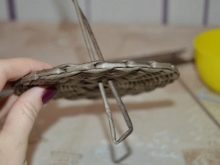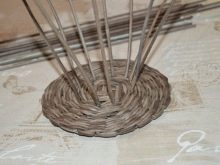Do-it-yourself home furnishings gained great popularity. In their manufacture, all available improvised materials and devices are used. Such a creative process requires a considerable amount of free time, but the result always exceeds expectations. We offer you to make candy cans from newspaper tubes with your own hands.
Features
Paper vine weaving has one big advantage. Paper has a much lower weight than the vine, and products from it are made lighter.
The paper vine is also more flexible and able to withstand steeper bends., which gives new opportunities when weaving.
Thanks to this, it became possible to manufacture small products.
Products made of paper vines are elegant and very beautiful.
When tinted correctly, they are very difficult to distinguish from objects made from natural vines. Basically, small items are made in this way to decorate the interior.

They complement the atmosphere of coziness and comfort in the home. Below is a master class on making several items from paper vines.
Newspaper vine
First of all, it is necessary to prepare a paper vine. For beginners, consider step by step the manufacture of newsprint vines.
The following materials and devices will be involved in this process:
- paper or newspaper;
- clerical knife;
- scissors;
- PVA glue;
- a small brush;
- knitting needle with a diameter of 2 mm;
- acrylic lacquer.
So, you need to take a newspaper and cut it along the fold line. On the resulting sheet, mark a strip with a width of 7-8 cm, and fold it across. Cut along the fold line. You should get a strip with a width of 7-8 cm and a length of about 30 cm.


Lay a sheet of paper on a flat, hard surface. Take a knitting needle, put it on the edge of the prepared sheet of paper at an angle of 20-30 degrees. Holding a sheet of paper with one crayfish, the other we begin to wind it on a knitting needle. Gently press the sheet to the spoke so that the tube is dense enough.
It is necessary to wind the paper so that the ends of the tube turn out to be of different diameters - one slightly larger than the other.
This is necessary for building paper vines. It will be inserted with the end with a smaller diameter into the end of another tube with a larger diameter.



At the end of this process, a small corner of the paper should remain, which must be greased with PVA glue and glued to a paper tube wound on a spoke. Carefully remove the paper vine from the knitting needle and allow the glue to dry.
To make a candy cane, you need about 50 of these newspaper tubes.
Do not rush when making such a straw. The tubes must be tight enough to make the product durable.
For final readiness, the tubes must be painted.
A water-based stain is ideal for this.



A rich color palette allows you to easily choose the right color. It is necessary to take a bunch of paper vines (15-20 pcs.) At one end, and lower the other into a container with a stain. Then remove, drain excess stains from the tubes and turn over. Repeat the operation with the unpainted end of the bundle of paper vines.
After the tubes are completely painted, they must be dried.
You need to catch such a moment, when the paper vine is a little damp. This will give it better elasticity, which is important when weaving. If the paper vine has dried completely and has become hard and inflexible, then it is necessary to sprinkle it with water from the spray gun.

It is necessary to moisten the middle part so that the ends of the vines remain solid.
Candy Cup
As mentioned above, to create a candy cup we need a minimum of costs and materials. This product is very functional and practical. It really helps to add to the tea ceremony an additional charm, comfort and presence of something home and family.
Cup weaving starts from the bottom.
To do this, take four pairs of paper vines and twist them crosswise in the center. In places of plexus a little grease with PVA glue. In the future, these tubes will be called guides.



Fold the next paper vine in half and put on 4 guides. Gently press it to the center of the plexus guides (middle of the bottom). The upper half of the tube is lowered down and passed under four adjacent guides. Raise the lower half up and spend on top of the adjacent 4 guides. And so we alternate in a circle. This method of weaving is called “rope”.
As weaving, the paper vine will end. To build up the tube, it is necessary to drop PVA glue into the hole of a larger diameter and insert a new vine into it
From the other end of the straw, it is necessary to do the opposite: put glue in a new vine and plant it on the thin end of the ending tube. Go through 3-4 rows with weaving and separate paired guides. Now you need to braid each guide.



Upon reaching the desired diameter of the saucer, we leave 1.5 cm on the working vine, cut off the rest. We hide the remaining ends with a knitting needle in a weave.
To make our saucer look finished, you need to close the edge of the weave.
It is necessary to take the guide, bend it to the side of the neighboring one, make a bend at their intersection and, departing from it 2 cm, cut off the rest. Tail the resulting tail next to the adjacent guide. So do with all the guides in a circle.



The bottom or saucer is ready.
Cup weaving also begins with the installation of guides.
Fold the paper vine in half and push them through the bottom of the saucer. We install them in such a way that the cup guide braids around the saucer guide.Then we bend one tube and put it on the guide cup. Weaving begins similar to weaving the bottom, only vertically.



After 3 rows, you need to insert some form for flying around. It can be any dish in the form of a hemisphere.
The guides must be evenly distributed, pressed against the mold and fixed with clips or clothespins at the edges.
The distance between the guides should not exceed 3 cm, otherwise weaving will be fragile. After reaching the desired height of the cup, finish weaving in the same way as when weaving the saucer.


To weave a pen, you need 3 paper vines.
2 tubes are placed parallel to each other. Glue the third vine to one of them at a distance of 2 cm from the edge. Let’s dry. In between the two tubes, insert two knitting needles for rigidity. With the third vine, we begin to braid the tubes with the knitting needles in eights, departing from the edge of 2 cm.

We finish weaving also 2 cm to the edge of the vine. We carefully remove the knitting needles, tuck the end of the third vine into weaving and glue it a little.
The braided handle is ready, it remains to attach it to the cup. To do this, with the help of a needle, the left ends of the handle of 2 cm are tucked into the weave at the top of the guide cup. We also act in the lower part. For rigidity, we lubricate these places with PVA glue. Let the cup dry completely.
To give strength to our candy store, it is necessary to primer it.
To do this, dilute the PVA glue with water in a 1: 1 ratio and apply the solution with a brush throughout the product.

Dry well and the mug is ready.
Vase
To weave an openwork vase for sweets, it does not take much time. You need to start with weaving the bottom. After the bottom has reached its size, take 5 guides through one on one side, 5 on the opposite side and lift them up. Secure them together at the top with a clip or clothespin. These are blanks for the future handle of the vase.
To perform openwork weaving, you need to take a pair of guides and run it under the adjacent guide.
Then lift up the next guide, lower down under another and bring up. It should make a small semicircle.




So do with all the guides. All ends of the rails should go up.
To shape the vase, you need to take a glass jar with a volume of one liter and put it on the bottom of the product.
Gently squeeze the weave around the jar and turn it upside down. Braid the remaining ends of the guides with three rows of weaving “rope” and finish weaving in the same way as when making the bottom of the cup. It will be a vase stand.



We form the handle of the vase and wrap the upper parts with a paper vine. For strength, lubricate with PVA glue.
Candy can with lid
Making a candy can with a lid is carried out in exactly the same way as in the case with the previous products. First you need to weave the bottom of a given size and then bend the guides up. Weave the "rope" to weave the required height of the candy box and finish the weaving.

At its core, the lid is the same bottom, with only a small handle in the center, for easy opening.
The lid is woven with a diameter slightly larger than the diameter of the candy box.
How to make candy cans from newspaper tubes, see the video below.









